Excessive Blinking in Children with Autism

Introduction to Excessive Blinking in Autism
Excessive blinking is a common and often misunderstood behavior observed in children with Autism Spectrum Disorder (ASD). While blinking naturally serves basic eye health functions, abnormal increases can signal underlying sensory, neurological, or emotional challenges. This article explores everything from causes, associated behaviors, research findings, to management strategies for this behavior, aiming to foster better understanding and support for affected children.
Causes of Excessive Blinking in Children with Autism
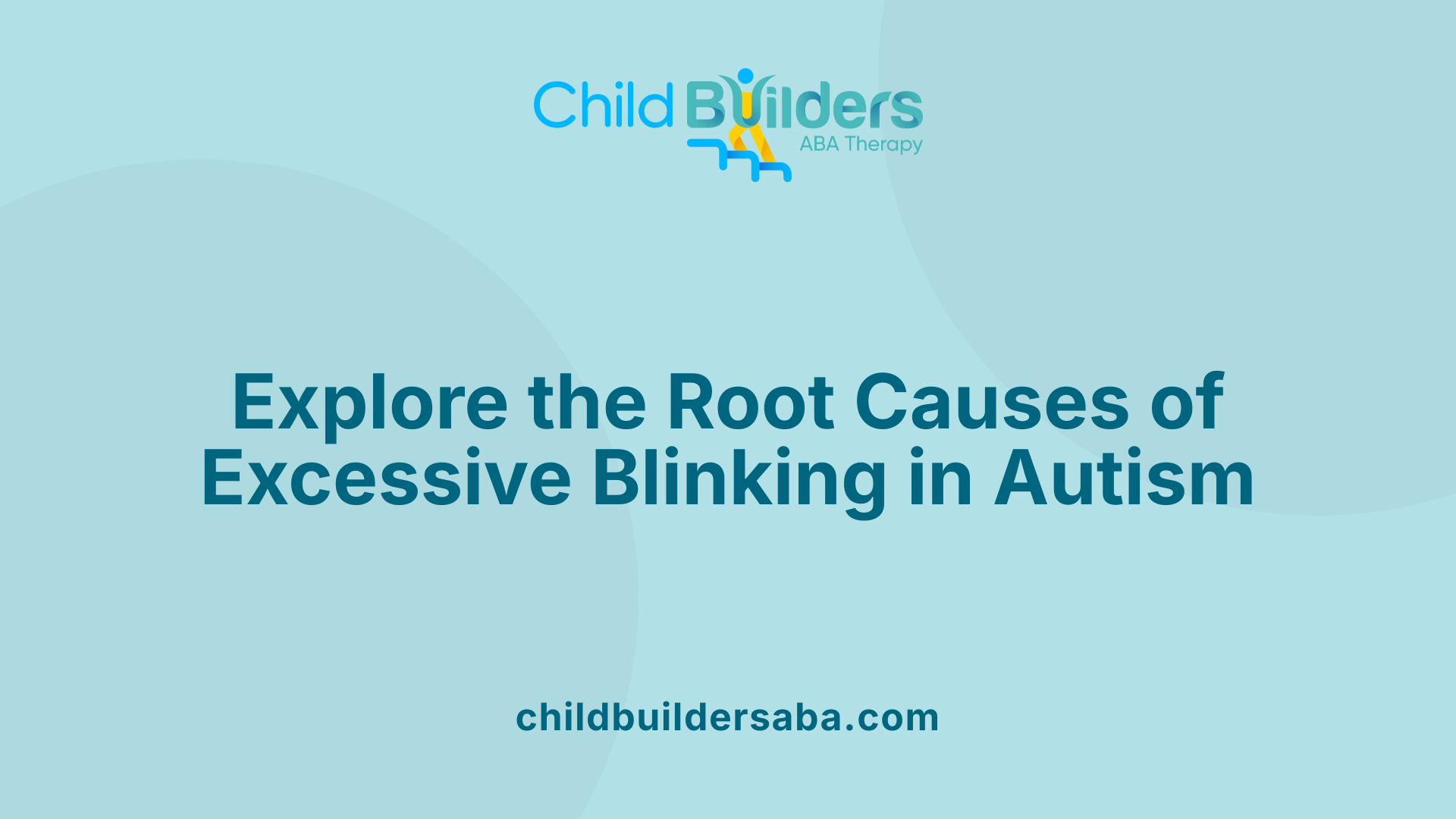
What are the causes of excessive blinking in children with autism?
Excessive blinking in children with autism often results from a mix of sensory, emotional, medical, neurological, and environmental factors. Understanding these causes can help caregivers and professionals develop effective strategies to manage and support affected children.
One significant contributor is sensory processing challenges. Children with autism frequently experience hypersensitivity to lights, textures, or other stimuli, which can lead to increased blinking as a way of coping with or reducing sensory overload.
Self-stimulatory behaviors, or stimming, are common in autism. Blinking can serve as a sensory regulation tool, helping children manage the influx of stimuli or calm themselves during overstimulating situations.
Emotional states such as anxiety and stress are closely linked to excessive blinking. When children feel overwhelmed, anxious, or anxious about social interactions, blinking may become a repetitive, self-soothing behavior.
Medical conditions also play a role. Eye-related issues like dry eyes, allergies, or refractive errors can cause discomfort, prompting increased blinking to alleviate irritation or correct vision problems.
Neurological issues, including tics and Tourette syndrome, are known to cause involuntary blinking. These neurological involuntary movements are often exacerbated by stress or fatigue.
Environmental influences such as prolonged screen time, poor lighting, or noisy settings can further trigger excessive blinking. These factors can intensify discomfort or overstimulation, leading to more frequent blinking behaviors.
Research indicates that differences in how children with autism process social and sensory information influence blinking patterns. For example, during social interactions, increased blinking may reflect heightened sensory or emotional processing demands.
Here is a summary table of potential causes:
| Cause | Details | Additional Notes |
|---|---|---|
| Sensory sensitivities | Hypersensitivity to lights, sounds, textures | Leads to blinking as a sensory reaction or stim |
| Self-stimulatory behaviors (stimming) | Blinking as a way to regulate sensory input or focus | Serves as a calming self-behavior |
| Anxiety and stress | Overwhelm during social or environmental situations | Can be exacerbated by fatigue or unfamiliar settings |
| Medical conditions | Dry eyes, allergies, refractive errors | Discomfort prompts increased blinking |
| Neurological issues | Tics, Tourette syndrome | Involuntary blinking due to neurological tics |
| Environmental factors | Screen overexposure, lighting, noise | Triggers overstimulation and blinking |
Understanding these causes helps in tailoring interventions. Addressing medical issues with healthcare professionals, reducing overstimulation, and implementing behavioral strategies like ABA therapy can effectively lessen excessive blinking. Recognizing the multifaceted roots of this behavior is essential for promoting comfort, social integration, and overall well-being for children with autism.
Behaviors Associated with Excessive Blinking
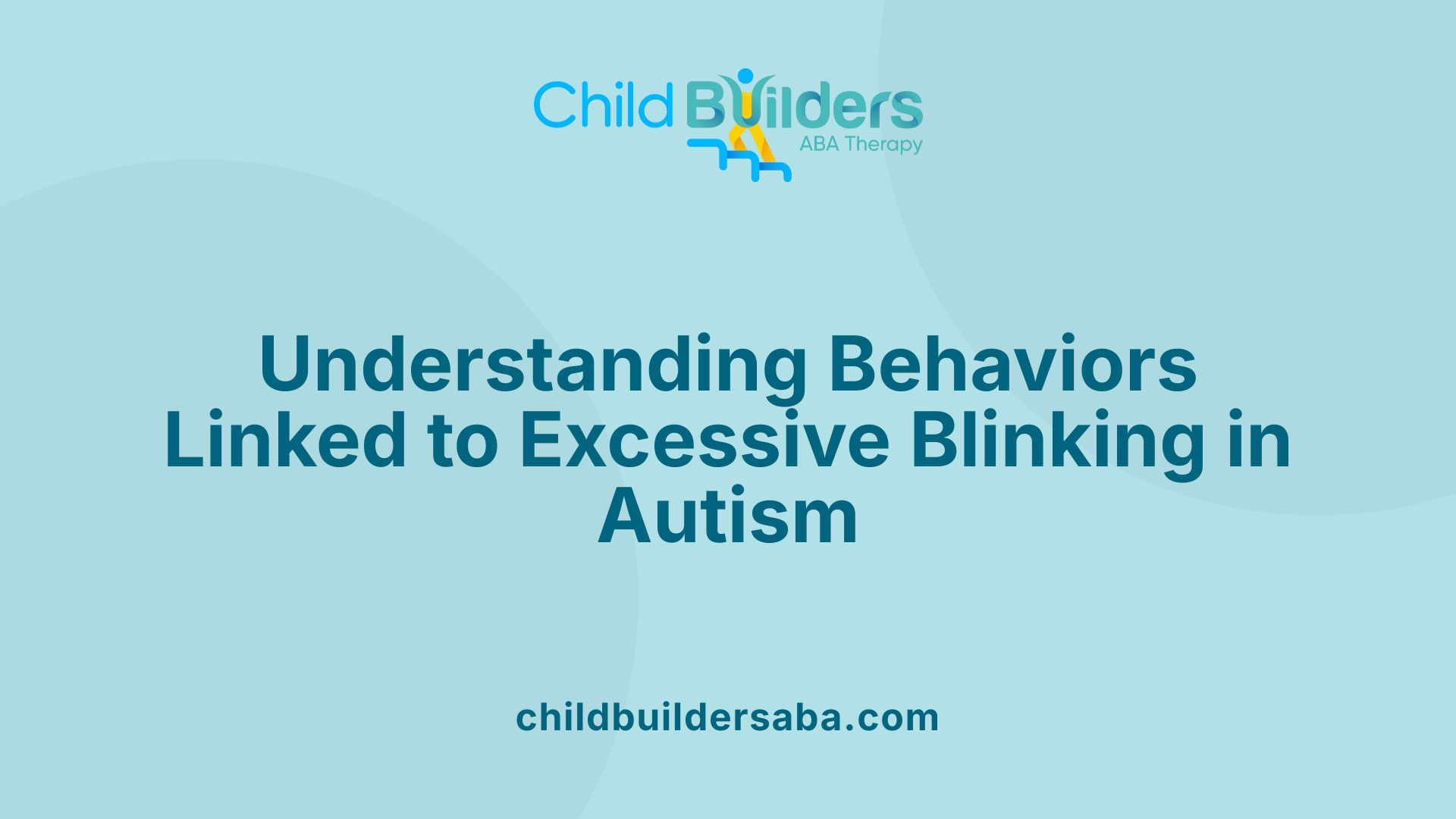
What behaviors are associated with excessive blinking in children with autism?
Excessive blinking in children with autism can be linked to a variety of behaviors and underlying factors. One prominent connection is with sensory processing challenges. Many children on the autism spectrum experience hypersensitivity to visual stimuli, such as bright lights or cluttered environments, which can lead them to blink more frequently as a way to cope with sensory overload.
Self-stimulatory behaviors, or stimming, are another significant aspect. Excessive blinking may serve as a form of self-regulation, helping children manage their emotions or focus their attention. This repetitive behavior can be a calming response to heightened sensory input or anxiety.
Triggers like bright lights, loud noises, or overstimulating environments often prompt increased blinking. These environmental factors can overwhelm a child's sensory system, causing them to use blinking as a sensory management tool.
Medical issues also play a role. Conditions such as eye irritation from allergies, dry eyes, or eye strain can cause children to blink more often. These physical discomforts might be mistaken for behavioral habits but often require medical attention.
Involuntary movements, particularly in cases involving tics or Tourette syndrome, are another cause. Tics are sudden, repetitive movements or sounds, and blinking can be one of the common involuntary eye tics seen in, for example, Tourette's.
Furthermore, neurological factors are thought to influence blinking rates. Some research suggests that increased dopaminergic activity—a neurochemical involved in motor control—may lead to higher frequencies of blinking in individuals with autism.
Addressing these behaviors involves a comprehensive approach. Behavioral therapies such as Applied Behavior Analysis (ABA) help identify triggers and teach children to replace excessive blinking with alternative, adaptive behaviors. Environmental modifications reduce sensory overload, and medical evaluations determine if underlying eye conditions or neurological factors require treatment.
Supporting children also includes implementing stress and anxiety management strategies, which can decrease the frequency of involuntary behaviors like excessive blinking. Family, caregivers, and educators working collaboratively with healthcare professionals can create an effective plan tailored to each child's needs.
In summary, excessive blinking in children with autism results from an interplay of sensory sensitivities, environmental triggers, medical issues, involuntary movements, and neurobiological influences. Recognizing these behaviors and their causes is crucial for developing appropriate interventions that improve comfort and social functioning.
Therapeutic Approaches and Interventions for Excessive Blinking
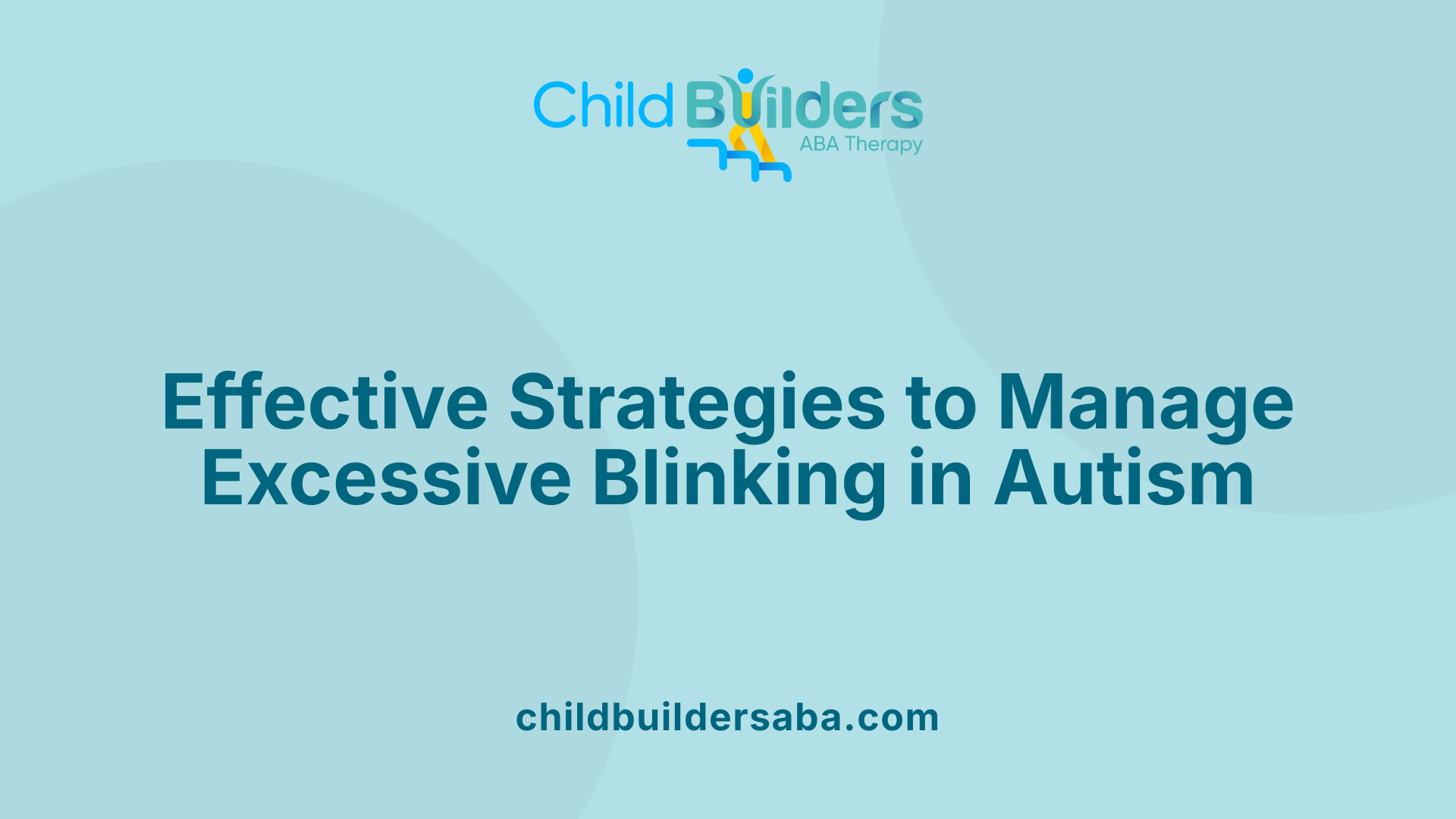
How can excessive blinking in children with autism be managed or treated?
Excessive blinking in individuals with autism is a symptom that often results from various underlying factors. Addressing this behavior involves several strategies that combine behavioral, medical, and environmental interventions to improve comfort and social functioning.
Behavioral therapies like Applied Behavior Analysis (ABA) are commonly used to modify specific behaviors, including excessive blinking. ABA therapy involves conducting behavioral assessments to identify triggers, teaching replacement behaviors, and reinforcing positive responses. This approach helps individuals develop alternative adaptive behaviors, such as relaxation techniques or sensory regulation strategies.
Habit reversal therapy, including Comprehensive Behavioral Intervention for Tics (CBIT), has shown particular effectiveness in reducing tic-like behaviors like excessive blinking. These therapies focus on increasing awareness of the behavior and teaching the individual to engage in competing responses that decrease the frequency of blinking.
Sensory integration and occupational therapies play a vital role in addressing sensory sensitivities that contribute to excessive blinking. These therapies involve activities that help desensitize overstimulated senses, improve sensory modulation, and develop coping skills, aiding in reducing the need for blinking as a self-regulatory response.
Medical evaluations are crucial when eye irritation or vision problems—such as dry eyes, allergies, or refractive errors—might be causing or worsening the excessive blinking. Consulting ophthalmologists or optometrists ensures underlying eye conditions are diagnosed and treated appropriately.
Stress and anxiety are common in children with autism and can exacerbate excessive blinking. Psychological approaches like Cognitive-Behavioral Therapy (CBT) are effective in teaching coping techniques, managing stress, and reducing anxiety-related triggers.
Furthermore, creating supportive environments through environmental modifications—like adjusting lighting, reducing overstimulation, and providing sensory supports—can decrease stress levels and sensory overload.
Involving caregivers in behavior management by maintaining consistent routines, observing and documenting behaviors, and collaborating with healthcare professionals enhances the effectiveness of treatments. Caregivers can help reinforce strategies at home and support their child's progress.
In summary, managing excessive blinking requires a multimodal approach that includes behavioral interventions, sensory support, medical treatment where necessary, and environmental adjustments. Tailoring these strategies to each child's unique needs offers the best chance of reducing symptoms and improving quality of life.
Research Findings on Blinking Patterns in Autism
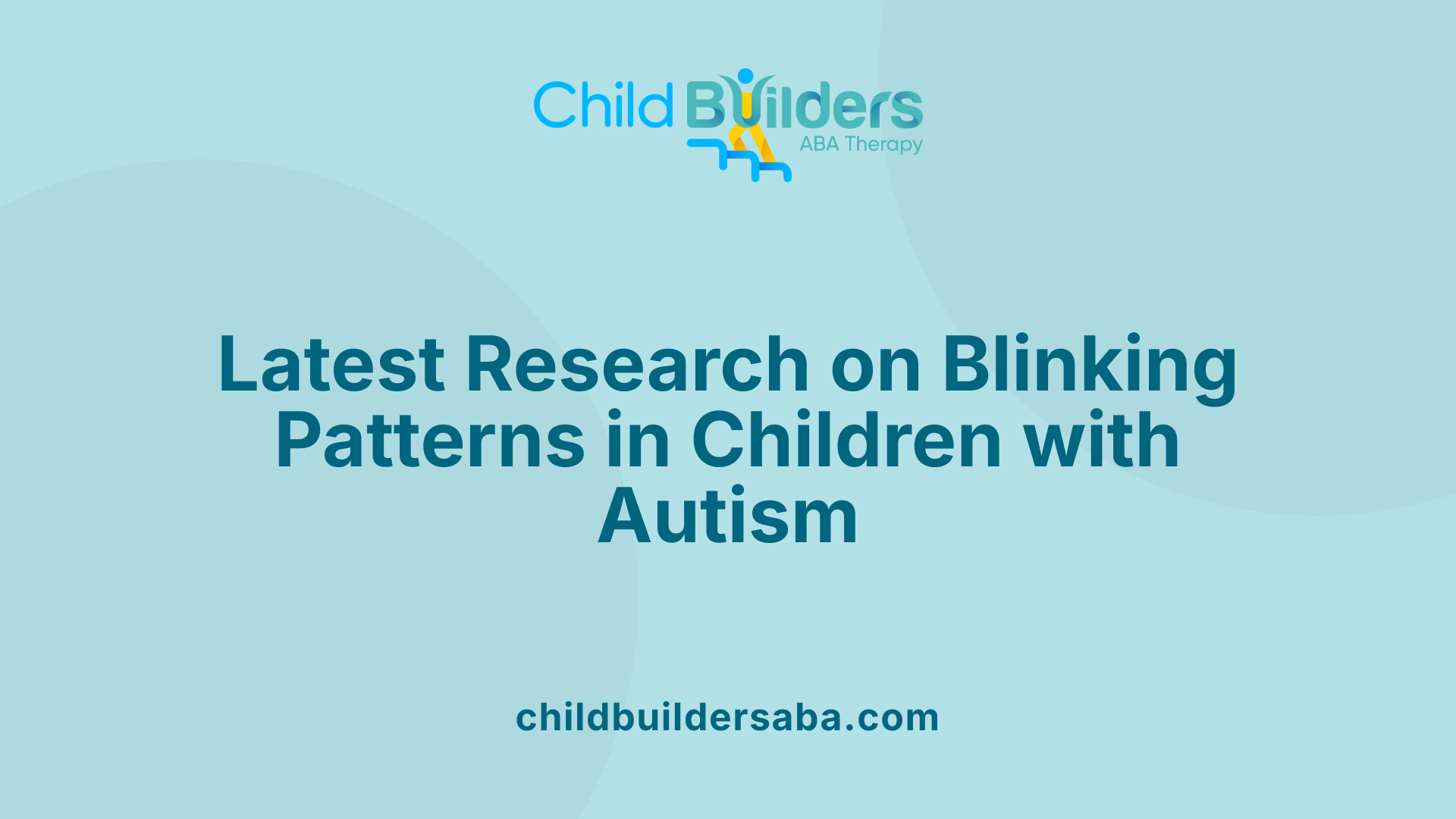
What are the research findings related to blinking patterns in children with autism?
Research into the blinking behavior of children with autism has uncovered significant differences compared to neurotypical children, especially during social and visual tasks. Notably, children with autism tend to have higher blink rates and less face orientation during social interactions or when viewing emotional stimuli. While typical children generally blink less and focus more intensely on faces during social cues, autistic children often display increased blinking, which may reflect differences in sensory processing or attention.
During emotionally charged segments of videos or social exchanges, children with autism frequently show a decreased face orientation and an increased tendency to blink. This contrasts with typical responses, where blink rates usually decrease during engagement with emotionally relevant content, indicating a higher level of focus. These blinking patterns can provide early markers for autism, assisting clinicians in diagnosing the disorder more accurately especially when combined with other behavioral and neurological assessments.
Underlying these behaviors are differences in brain functioning. Neurological studies suggest that regions such as the cerebellum and limbic system—which are involved in learning, emotional processing, and conditioning—exhibit abnormalities in individuals with autism. These differences may influence eye-blink responses and attentional engagement, explaining why these children might display atypical blinking patterns during social interactions.
Understanding these blinking behaviors offers valuable insights into how children with autism process social information. The variations in blinking and face orientation serve as indicators of social interest and attentional focus, which are core areas of challenge in autism spectrum disorder. Early detection through analyzing blinking patterns could lead to timely interventions aimed at improving social skills and emotional understanding.
In addition, research suggests that these behaviors reflect underlying neurological and sensory sensitivities. For example, heightened or reduced blinking can result from sensory overload or discomfort, further impacting social participation and learning. Recognizing these patterns not only aids diagnosis but also informs tailored therapeutic approaches, including behavioral and sensory integration therapies.
By examining blinking responses in various contexts—such as during emotional scenes, social conversations, or physical movements—researchers can better understand the attentional engagement levels and social interest of children with autism. This knowledge can facilitate the development of targeted strategies to promote social engagement and reduce sensory overload, ultimately improving daily functioning and quality of life.
| Aspect | Findings | Additional Details |
|---|---|---|
| Blink Rates | Increased in children with autism | Especially during passive or non-social activities |
| Face Orientation | Less frequent during social tasks | Indicates possible difficulties with social attention |
| Response to Stimuli | Less decrease in blink during emotional/social content | Shows attention and interest differences |
| Neurological Links | Cerebellar and limbic system abnormalities | Affect learning, emotional processing, and eye responses |
| Implications | Early markers and intervention tools | Helps identify autism earlier and tailor therapies |
| Sensory Processing | Variability related to sensitivities | Affects blinking and focus during social interaction |
Understanding these nuanced blinking behaviors enhances our comprehension of how children with autism experience their social environment. This knowledge aids in refining diagnostic procedures, creating targeted interventions, and ultimately supporting better social and emotional outcomes.
Implications of Excessive Blinking in Children with Autism
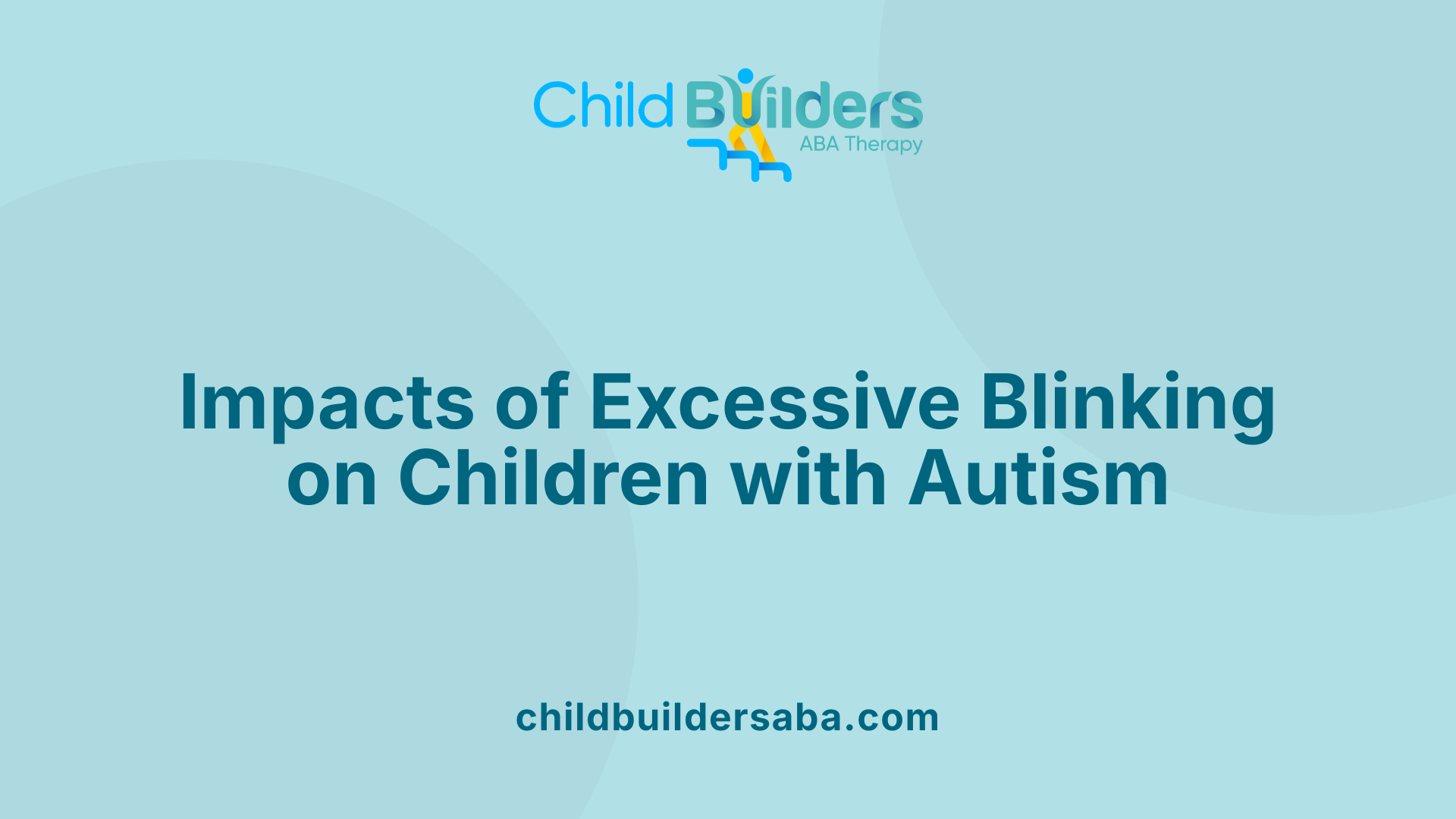
What are the implications of excessive blinking for children with autism?
Excessive blinking in children with autism often indicates underlying sensory sensitivities, where the child may be overwhelmed by bright lights, textures, or auditory stimuli. This behavior can also stem from eye discomfort, such as dryness or irritation, and from emotional states like anxiety or stress.
Stimming, or self-stimulatory behaviors, frequently include excessive blinking as a way for children to regulate sensory input or reduce anxiety. These behaviors can be thought of as coping mechanisms helping children manage overstimulation or emotional stress.
Neurologically, increased blinking may reflect dopaminergic hyperactivity, which is linked to certain neurological processes associated with autism. Such behaviors can serve as behavioral signs that highlight how a child processes sensory or social information.
From a social perspective, excessive blinking can attract unwanted attention. That may lead to feelings of self-consciousness or fatigue, which further hampers social interactions and communication efforts.
Research indicates that children with autism tend to have different blinking patterns during social and physical activities. For example, they may blink more frequently when engaging with others or watching videos, compared to neurotypical children. These increased blink rates can be correlated with the severity of autism and social disengagement.
Furthermore, higher blinking frequency might be a useful digital biomarker for early detection. Recognizing these patterns can assist in diagnosing autism more promptly and tailoring interventions more effectively.
The behavioral and emotional effects of excessive blinking can extend beyond social discomfort. Some children may become self-conscious, leading to withdrawal, while physical fatigue may set in from sustained repetitive behaviors.
Addressing excessive blinking is crucial because it can significantly influence a child's emotional well-being and capacity to participate in social, educational, and daily activities. Therapeutic approaches such as sensory integration therapy, behavioral intervention (including ABA therapy), vision therapy, and anxiety management techniques aim to reduce these behaviors.
By focusing on the root causes, professionals and caregivers can help diminish excessive blinking, fostering a more comfortable and engaging environment for children with autism. Ultimately, managing this behavior supports enhanced social interactions, better emotional health, and improved quality of life.
Support Options and Practical Tips for Caregivers
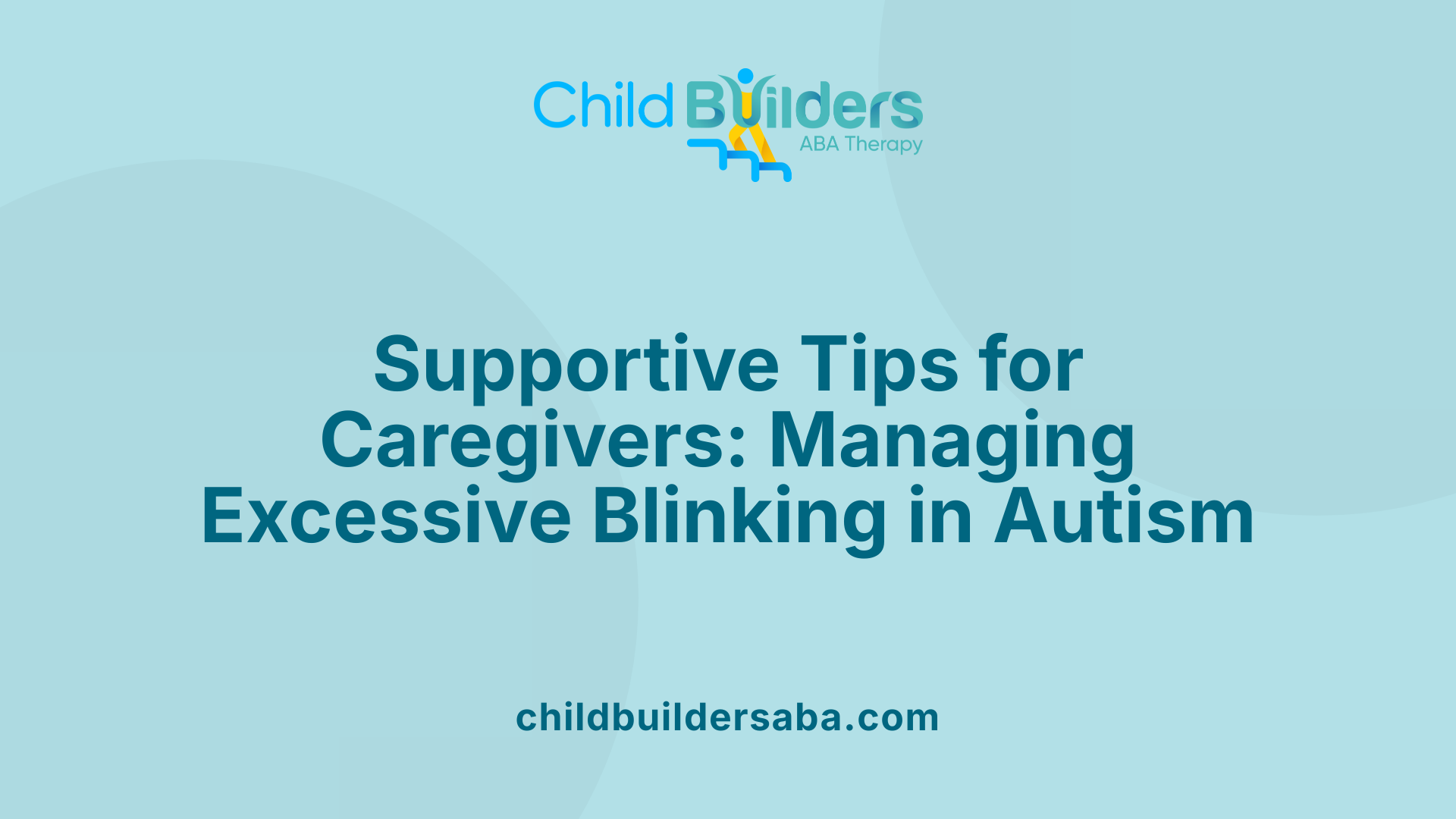
What support options are available for addressing excessive blinking in children with autism?
Support strategies for managing excessive blinking in children with autism encompass a range of approaches aimed at reducing the behavior and improving overall well-being. Behavioral therapies such as Applied Behavior Analysis (ABA) are commonly used to identify specific triggers and teach replacement behaviors that serve the same purpose but are less disruptive. For example, children may be encouraged to engage in deep breathing exercises or use sensory tools to help regulate their sensory input.
Occupational therapy, especially sensory integration therapy, can assist children in managing sensory sensitivities that often contribute to excessive blinking. This therapy focuses on gradually desensitizing over-stimulating environments and teaching children new ways to process sensory information more comfortably.
Medical evaluation is a critical component. Consulting with healthcare professionals like ophthalmologists or allergists helps rule out physical causes such as eye irritation, dryness, or allergies that might be aggravating the behavior. Addressing these issues through medical intervention can significantly reduce the stimulus for excessive blinking.
Creating a calm and sensory-friendly environment is another effective support measure. This includes adjusting lighting, reducing loud noises, and providing sensory aids like fidget toys, weighted blankets, or noise-canceling headphones. These tools can help decrease stress levels and sensory overload.
Supporting self-regulation and routine management is vital. Developing structured routines and visual supports assists children in understanding expected behaviors and provides a sense of predictability, which can lessen anxiety and stress.
Collaboration with professionals such as psychologists, optometrists, and educational specialists helps develop targeted strategies tailored to each child's needs. Regular monitoring of environmental factors and triggers allows caregivers to make necessary adjustments.
How can observation and documentation help in managing excessive blinking?
Caregivers and parents should observe and document blinking behaviors over time. Recording the frequency, duration, context, and any antecedent triggers provides valuable insights. For example, noting if blinking increases during certain activities or in specific environments can help identify precise factors that elicit the behavior.
Using a behavior journal or digital logs enables caregivers to track patterns and share detailed information with professionals. This data-driven approach informs more effective intervention strategies, whether through behavioral therapy or medical evaluation.
Why is a medical evaluation important?
Medical assessments by eye specialists or other healthcare providers are essential to rule out physical causes of excessive blinking. Conditions such as dry eyes, eye strain, allergies, or neurological issues like tics and Tourette syndrome could be underlying factors.
Addressing medical issues may involve treatments such as eye drops, medication adjustments, or allergy management, which can significantly reduce the physical discomfort or involuntary tics that cause excessive blinking.
How can creating a calming environment benefit children with ASD?
Providing a calming, sensory-friendly environment helps reduce stress and overstimulation, which are common triggers for excessive blinking. This involves adjusting lighting to softer or natural levels, minimizing loud sounds, and incorporating calming sensory inputs like textured surfaces or weighted objects.
Routine calming activities, such as soft music, deep pressure techniques, or quiet space time, can help children better regulate their emotions and reduce behaviors associated with anxiety or sensory overload.
What role do visual supports and sensory tools play?
Visual supports like visual schedules, social stories, or cue cards can help clarify expectations and transitions, reducing anxiety and unexpected triggers. Sensory tools such as fidget toys, chewable jewelry, or sensory bins offer alternative ways to satisfy sensory needs, decreasing the likelihood of habits like excessive blinking.
How should caregivers collaborate with professionals?
Building a team of support includes regularly consulting with psychologists, occupational therapists, optometrists, and educators. Sharing observations, progress, and concerns ensures strategies are tailored and consistently applied across settings.
Open communication and joint planning are fundamental to adjusting interventions as needed and ensuring a comprehensive support plan for the child.
How can caregiver support promote self-advocacy and routine management?
Encouraging children to communicate their needs and preferences promotes self-awareness and control. Teaching children self-regulation techniques, reinforcing positive behaviors, and maintaining consistent routines foster independence.
Celebrating small successes and continuously adapting strategies contribute to better management of behaviors like excessive blinking, leading to improved comfort and social participation.
Conclusion and Support Strategies
Addressing excessive blinking in children with autism requires a multi-faceted approach that recognizes its diverse causes and manifestations. Understanding the behaviors and underlying triggers enables caregivers and professionals to implement targeted interventions, including behavioral therapies, sensory integration, and medical evaluations. Creating supportive, sensory-friendly environments and engaging in consistent collaboration with healthcare providers can significantly improve the child's comfort and social engagement. With careful management and patience, the impact of excessive blinking can be minimized, contributing to a better quality of life for children with autism and their families.
References
- Understanding Excessive Blinking in Autism - True Progress Therapy
- Understanding Excessive Blinking in Autism - Move Up ABA
- Blinking Patterns Give Insight to Autism - HCPLive
- Understanding Excessive Blinking in Autism | All Star ABA
- Excessive Blinking in Autism | Little Champs ABA
- Understanding Excessive Blinking in Autism - True Progress Therapy
- Understanding Excessive Blinking in Autism - Move Up ABA
- Understanding Excessive Blinking in Autism | All Star ABA
- Excessive Blinking in Autism | Little Champs ABA
- Understanding Excessive Blinking in Autism - True Progress Therapy



.jpg)

































































































